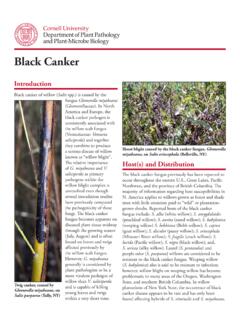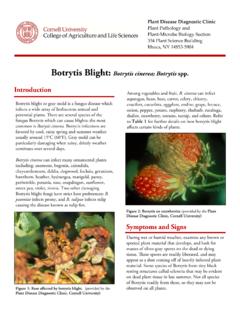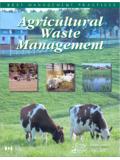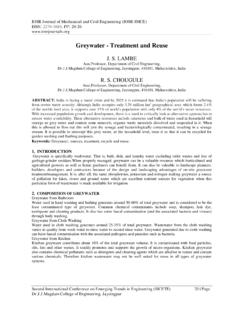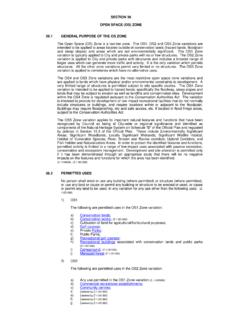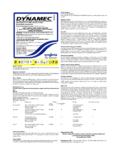Transcription of Bacterial Wilt of Cucurbits: Erwinia tracheiphila
1 Bacterial wilt of Cucurbits: Erwinia tracheiphilaSymptoms of the disease first appear on a single leaf which suddenly wilts and becomes dull green ( ). The wilting symptoms spread up and down the runner sometimes as a recurring wilt on hot, dry days. Soon infected runners and leaves turn brown and die. The bacteria spread through the xylem vessels of the infected runner to the main stem, then to other runners. Eventually the entire Symptoms and Signs Figure 2 & 3: Close up of Bacterial ooze from stems of infected plants (provided by the S. Jensen, Cornell University) Disease Cycle This vascular wilt disease caused by the bacterium Erwinia tracheiphila affects only certain members of the cucumber family including cucumber, squash, muskmelon, pumpkin, and gourd. Watermelon is immune and certain varieties of cucumber and squash show varying degrees of resistance to this dis-ease.
2 Bacterial wilt causes losses of 10 to 20 percent in unsprayed plantings of susceptible cucurbits. Introduction Figure 1: Symptoms of yellowing, wilting and dieback of the foliage of squash (provided by the Plant Disease Diagnostic Clinic, Cornell University) plant shrivels and dies. Less susceptible plants, such as certain squash varieties, may show dwarfing of growth before the wilt symptoms become apparent. Bacterial wilt is an unusual disease in that the Bacterial pathogen can survive the winter only in the digestive tract of striped cucumber beetles and spotted cucumber beetles. In spring the overwintered bacteria land on cucurbit leaves within the fecal droppings of beetles which have begun to feed on the plants. The bacteria can then infect the plant through wounds produced by the feeding of the beetles or other chewing insects.
3 Bacteria cannot infect the plant through normal plant openings (stomates and hydathodes) nor are they carried on or in seed. The beetles' mouthparts become contaminated with the bacteria while feeding on infected leaves. In this manner the beetles carry the bacteria to the next three Plant Disease Diagnostic Clinic Plant Pathology and Plant Microbe Biology Section 334 Plant Science Building Ithaca, NY 14853 5904 Management Strategies additional products containing horticultural oil or malathion may be registered to manage beetles on melons in New York. Insecticides will provide control of the beetles if applied when beetles first appear in the spring. Early control, beginning as soon as the plants emerge, is most important as a single beetle can introduce the bacteria. One to four generations of the beetle may occur on unprotected plants, and applications of these insecticides at w eekly intervals may become necessary.
4 Apply a light even coating of the insecticide over the entire plant, especially where the stem emerges from the soil (that is where the beetles often congregate). References: Compendium of Cucurbit Diseases, eds. Zitter, D. L. Hopkins, and Thomas, APS Management Around the Home. To purchase see: Cornell University Vegetable MD Online: updated, SLJ 1/18 or four plants on which they feed. Beetles apparently prefer to feed on plants with Bacterial wilt symptoms. Fortunately, only a small number of beetles become active carriers of the bacteria and infection can only take place when there is a film of water on the leaf sufficient for the bacteria to reach a wound and gain entry into the inner leaf tissue. Weather conditions have an indirect effect on the disease. Environmental conditions which favor the over-wintering, feeding, and reproduction of the cucumber beetles will affect the prevalence of Bacterial wilt .
5 A year with a good winter snow cover followed by a warm March and April could be expected to increase the number of beetles and therefore increase the incidence of Bacterial wilt . Bacterial wilt may be reduced by controlling the cucumber beetles. They may be prevented from feeding on plants in the home garden by enclosing the plants in wire or cheesecloth tents supported by a wooden or wire framework as soon as they come through the ground in the spring. The cheesecloth is stretched over the frame and its lower edges weighted with stones or soil to prevent beetles from crawling underneath. This tent should be removed as soon as the plant becomes well established. Larger plantings must be protected by insecticides. Some permethrin, neem oil, carbaryl, insecticidal soap or pyrethrin-combination products are registered to manage cucumber beetles on cucumber in the home garden in New York State.
6 If needed, READ THE LABEL BEFORE APPLYING ANY PESTICIDE! Changes in pesticide regulations occur constantly. All pesticides distributed, sold, and/or applied in New York State must be registered with the New York State Department of Environmental Conservation (DEC). Questions concerning the legality and/or registration status for pesticide use in New York State should be directed to the appropriate Cornell Cooperative Extension Specialist or your regional DEC office. The Plant Disease Diagnostic ClinicDiPhone: 607 255 7850 Fax: 607 255 4471 Email: Web.
